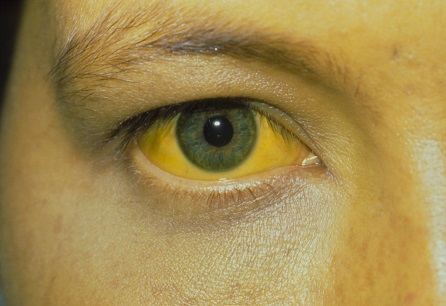Resumo
Diagnósticos diferenciais
comuns
- Doença hepática relacionada ao álcool
- Coledocolitíase
- Hepatite A
- Hepatite B
- Hepatite C
- Lesão hepática induzida por medicamentos
- Colangite ascendente
- Carcinoma pancreático
- Metástases hepáticas
- Anemia hemolítica
- Cirrose descompensada
- Insuficiência hepática aguda
- Insuficiência hepática crônica agudizada
Incomuns
- Síndrome de Gilbert
- Hepatite E
- Hepatite D
- Leptospirose
- Colangiopatia relacionada à imunoglobulina G4 (IgG4)
- Colangiocarcinoma
- Carcinoma hepatocelular (CHC)
- Estenose pós-operatória
- Colangite esclerosante primária
- Colangite biliar primária
- Doença de Wilson
- Hemocromatose hereditária
- Deficiência de alfa 1-antitripsina
- Infecções parasitárias
- Colangiopatia relacionada à síndrome de imunodeficiência adquirida (AIDS)
- Insuficiência cardíaca
Colaboradores
Autores
Janisha Patel, BSc, PhD, MBChB
Consultant Hepatologist
University Hospital Southampton
Southampton
UK
Declarações
JP declares that she has no competing interests.
Alex Smith, MBChB MRCP
Hepatology Specialist Registrar
University Hospital Southampton
Southampton
UK
Declarações
AS declares that he has no competing interests.
Agradecimentos
Dr Janisha Patel and Dr Alex Smith would like to gratefully acknowledge Dr Rene Ramnarace, Dr Harry R. Dalton, Dr Peter Draganov, and Dr Grant F. Hutchins, previous contributors to this topic.
Declarações
RR, HRD, PD, and GFH declare that they have no competing interests.
Revisores
Jeffrey S. Upperman, MD, FACS, FAAP
Associate Professor of Surgery
Division of General Pediatric Surgery; Director of the Trauma Program
Children's Hospital
Los Angeles
CA
Declarações
JSU declares that he has no competing interests.
Grant Sanders, MBBS
Consultant
Laparoscopic Upper Gastrointestinal Surgeon
Derriford Hospital
Plymouth
UK
Declarações
GS declares that he has no competing interests.
Jawad Ahmad, MD, FRCP, FAASLD
Professor of Medicine
Division of Liver Diseases
Mount Sinai Hospital
New York
NY
Declarações
JA declares that he has no competing interests.
Créditos aos pareceristas
Os tópicos do BMJ Best Practice são constantemente atualizados, seguindo os desenvolvimentos das evidências e das diretrizes. Os pareceristas aqui listados revisaram o conteúdo pelo menos uma vez durante a história do tópico.
Declarações
As afiliações e declarações dos pareceristas referem--se ao momento da revisão.
Referências
Principais artigos
Jophlin LL, Singal AK, Bataller R, et al. ACG clinical guideline: alcohol-associated liver disease. Am J Gastroenterol. 2024 Jan 1;119(1):30-54.Texto completo Resumo
Fontana RJ, Liou I, Reuben A, et al. AASLD practice guidance on drug, herbal, and dietary supplement-induced liver injury. Hepatology. 2023 Mar 1;77(3):1036-65.Texto completo
Bajaj JS, O'Leary JG, Lai JC, et al. Acute-on-chronic liver failure clinical guidelines. Am J Gastroenterol. 2022 Feb 1;117(2):225-52.Texto completo Resumo
Biggins SW, Angeli P, Garcia-Tsao G, et al. Diagnosis, evaluation, and management of ascites, spontaneous bacterial peritonitis and hepatorenal syndrome: 2021 practice guidance by the American Association for the Study of Liver Diseases. Hepatology. 2021 Aug;74(2):1014-48.Texto completo Resumo
American College of Radiology. ACR appropriateness criteria: jaundice. 2018 [internet publication].Texto completo
Artigos de referência
Uma lista completa das fontes referenciadas neste tópico está disponível para os usuários com acesso total ao BMJ Best Practice.

Diretrizes
- ACG Clinical guideline: alcohol-associated liver disease
- ACG Clinical guideline: diagnosis and management of biliary strictures
Mais DiretrizesFolhetos informativos para os pacientes
Cálculos biliares
Hepatopatia alcoólica
Mais Folhetos informativos para os pacientesCalculadoras
Escore para hepatite alcoólica de Glasgow
Escore MELD para doença hepática de estágio terminal (NÃO é adequado para pacientes com menos de 12 anos de idade) (unidades SI)
Mais CalculadorasVideos
Demonstração animada de uma paracentese abdominal
Mais vídeosConectar-se ou assinar para acessar todo o BMJ Best Practice
O uso deste conteúdo está sujeito ao nosso aviso legal